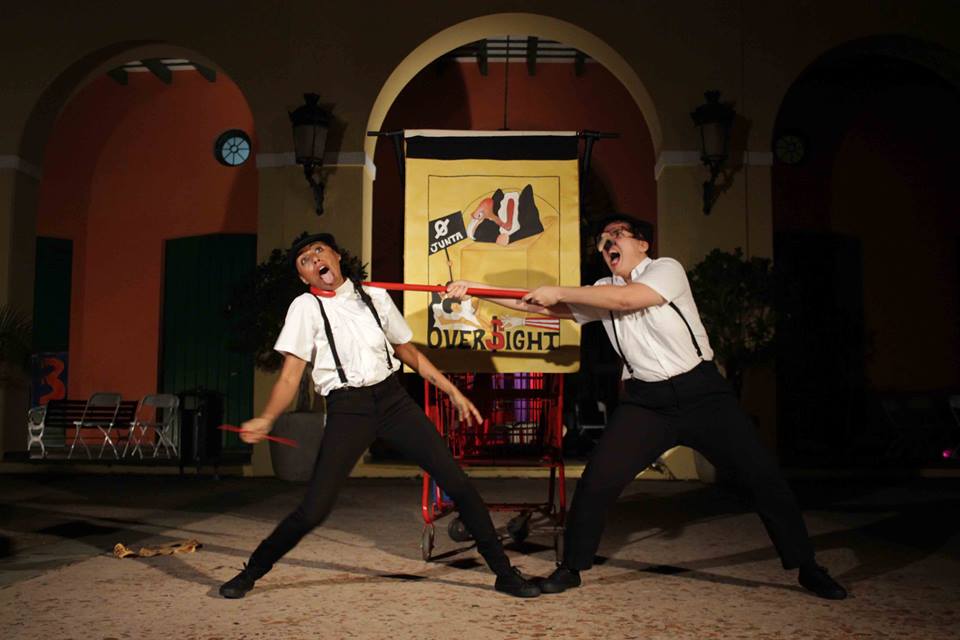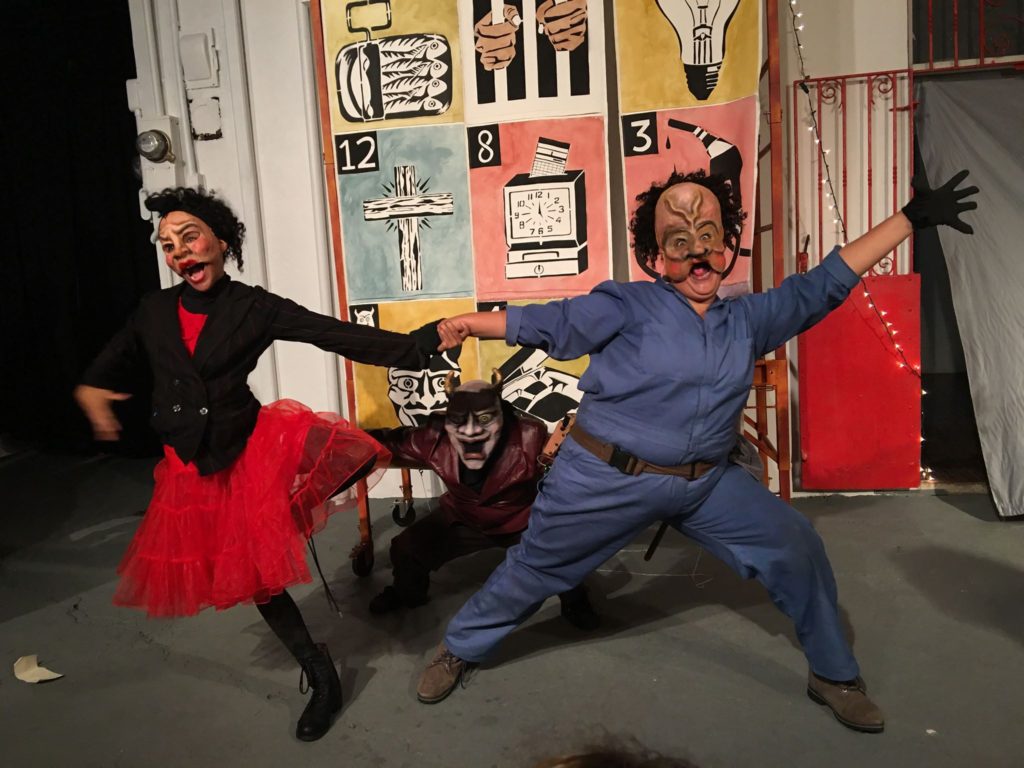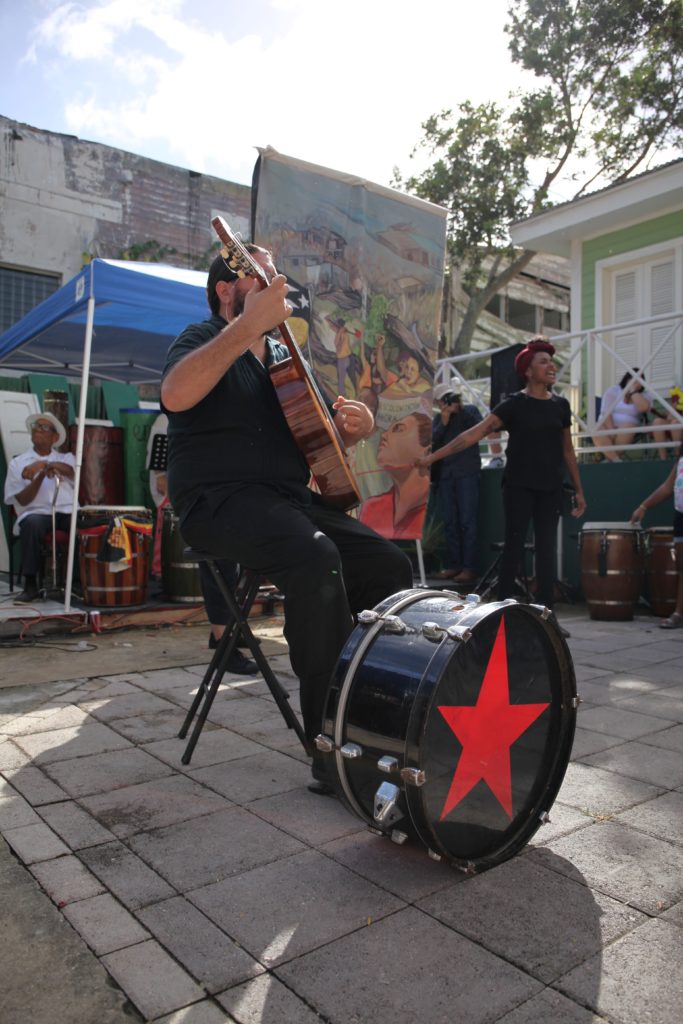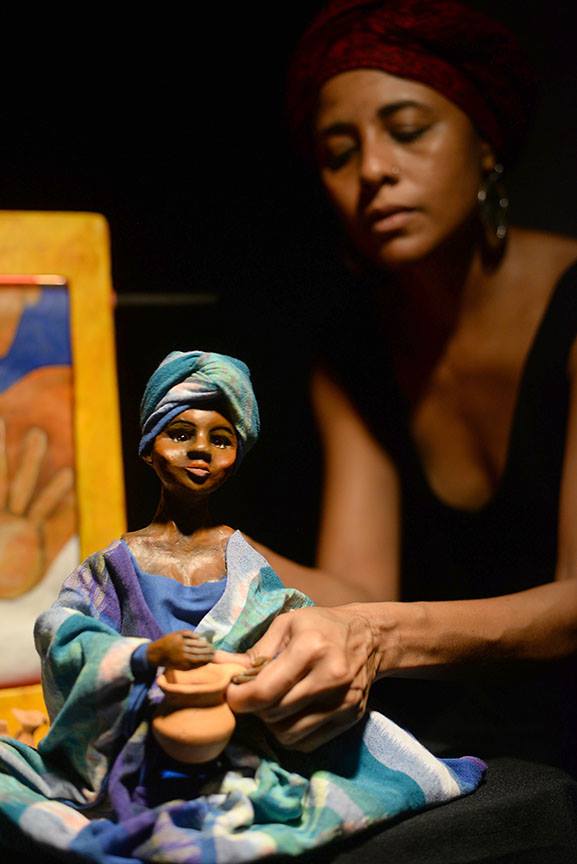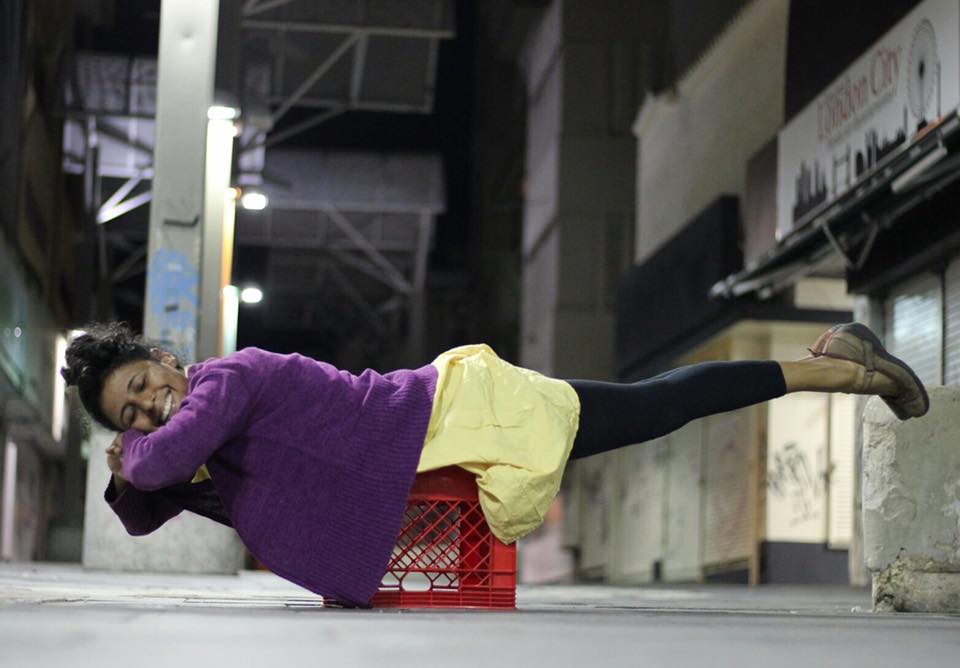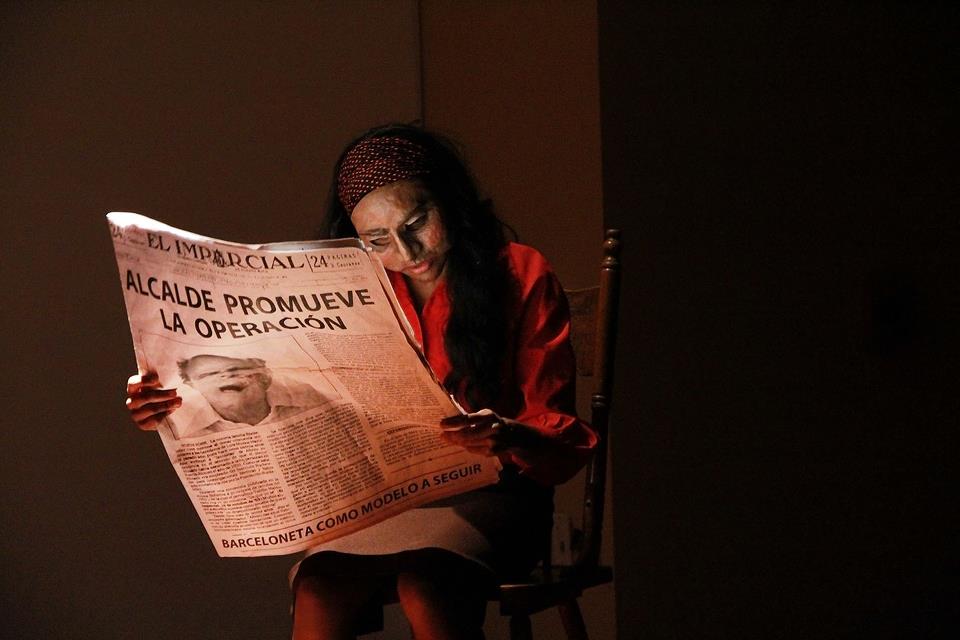Published December 2020
AgitArte: How did you first become engaged with AgitArte | Papel Machete?
Sugeily:
I met Jorge Díaz (Co-Director of AgitArte) in 2005 in Teatro Estudio Yerbabruja (Yerbabruja Studio Theatre) in Río Piedras. At that time, we were celebrating “Mixta con Tod@s 6” – a performance marathon – organized by Margarita Espada and Deborah Hunt. I helped run the event while Jorge participated in “ANIMAS”, a mask theater piece directed by Deborah Hunt in collaboration with people from “Santurce No Se Vende” (Santurce Is Not for Sale), a group composed by Santurce residents, artists, and workers who at that time were fighting against the expropriation of the San Mateo de Cangrejos neighborhood.
Following that first encounter, Jorge and I kept coincidentally meeting at protests, puppetry / mask making workshops, and theater events organized by Deborah. One of which was Titeretada, our annual puppetry festival in which we have been part of the organizing committee from its inception in 2008 to the present. This space allowed us to get to know each other’s work and deepen our friendship, but it wasn’t until summer of 2009 that I began collaborating directly with AgitArte and Papel Machete. Jorge called me to do two things: help facilitate a puppet workshop that AgitArte was organizing in Villa Cañona and participate in a parade with Papel Machete and the community during the traditional festivities of Santiago Apóstol in Loiza.
The purpose was to protest against the racist expressions of the then mayor of Loíza, who had threatened with suspending the festivities because he considered them “from the devil”, in a violent attempt to whiten and gentrify a predominantly black community and its culture. I remember arriving at the communal center of Villa Cañona with a bag full of brushes and paints to facilitate a puppet and mask workshop together with Jorge and colleagues from Papel Machete, and then march in protest with the community under the slogan “Cultura es Lucha” (Culture is Fight). It was there, among puppets, banners, music, vejigantes and community cultural resistance, that my journey with AgitArte and Papel Machete began.
I joined Papel Machete in 2009 and shortly afterwards was invited to be part of the Board of Directors of AgitArte, in which I participated for 6 years. My relationship with Papel Machete and AgitArte has been united from the beginning: they are my family, our house-entrenchment, and creative sanctuary; from there we continue to fight for our liberation and for a transformation of our society that ensures a dignified and fair life for all.
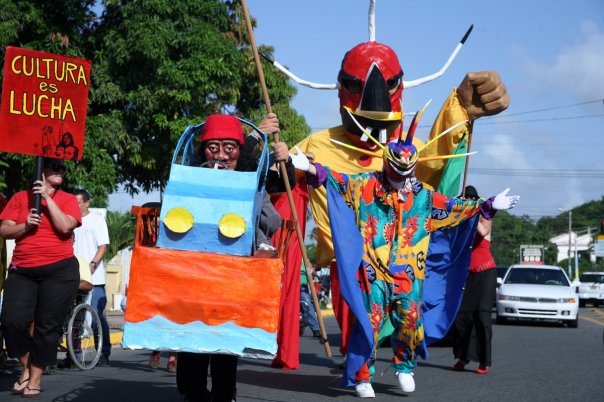
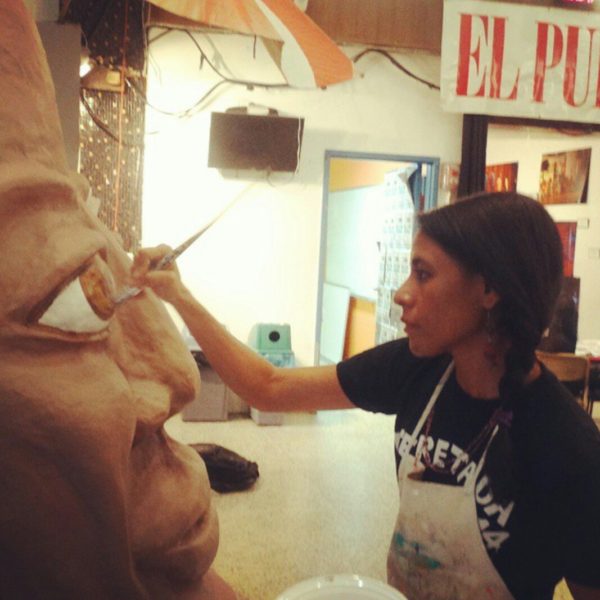
AgitArte: What is your creative background, both in education and through other means of developing your artistic practice(s)?
Sugeily:
The first time I did theater I was 12 years old. The play dealt with different social problems that we were facing in our communities. From this point on my interest in theater began to grow and I signed up for a drama class when I moved on to middle school. During those years my mom encouraged me to join the school band. I learned (more or less) to play the flute, and I joined the marching band. In the afternoons when classes ended, we did our practices in the sun at 3pm, and sometimes we went out to march through the town. I was fascinated by the formations.
Around the same time, I began taking painting classes with former political prisoner Pablo Marcano García a few years after his release. Pablo is the only painting teacher I have ever had and was fundamental in my artistic and political development. Although these experiences occurred at a very elementary stage of my life, they defined much of what I do today, and many of them I owe to brave women: my mother Ana Cecilia, my grandmother Nereida and my great-aunt Luz María who always insisted in my artistic and political development.
I began studying at University of Puerto Rico in Cayey in 1995, and immediately joined the student organization Café Teatro and also started to work in the department of Cultural Activities. At Café Teatro I started doing the scenographies for the events and ended up chairing the organization for several years. One of the experiences that marked that university period was the Encuentro de Teatro Popular Latinoamericano, ENTEPOLA (Latin American Popular Theater Festival), an event that originated in Chile by the popular theater group “La Carreta.” At this festival, I met artists who were themselves activists and organizers from different countries in Latin America. Although I finished a bachelor’s degree in history, I took all possible electives in theater. Also during those years I led – together with other students – the fight for the preservation of our theater “La Casita de Histriones” which was threatened to be destroyed in order to build a natural sciences building. I owe my academic training in theater to my great teachers Jorge Luis Torres and Rafael Fuentes. During my senior year of university I decided to organize, together with Oscar González and Ivette Cruz, “Aspaviento”, an experimental theater group of puppets and objects.
The creation of Aspaviento coincides with the opening of the Teatro Estudio Yerbabruja. I arrived on the opening day in 2000 thanks to my friend and teacher Pedro Santaliz. There I met Margarita Espada and Deborah Hunt. I immediately got involved in Yerbabruja’s life helping organize the “Mixtas con tod@s”, as part of the Board of Directors and, alongside Deborah, with the administration of the theater. With Deborah, a new cycle begins in my artistic training. I started taking her puppet and mask workshops in 2003 and since then have collaborated and conspired together on different projects. Besides, the possibility of being part of Papel Machete while being able to collaborate with other artists keeps me in the spirit of continuing to learn and create.
Papel Machete has been my political home, my place of militancy, growth, and love. I feel I have learned more from my comrades than what I have been able to offer, this being such a skillfully diverse group of workers. I can’t imagine any fight not alongside them.
AgitArte: What do you feel you’ve gained as an artist through your work with AgitArte | Papel Machete? What do you feel have been your greatest contributions to AgitArte | Papel Machete?
Sugeily:
For me, AgitArte and Papel Machete are community, family and sustenance.. Working from a continuous scenario of crisis and survival is in itself an act of resistance. It always remains a challenge to create because you have to constantly give yourself without much possibility of time to recharge. Still we continue because we know that each day will bring what is necessary to sustain us.
I have seen how within the collective work, great and small victories are accomplished. Casa Taller Cangrejera is one of those big accomplishments. With much effort we have achieved a safe and necessary space to continue our work and to directly support the people’s struggle and grassroots artwork.
Papel Machete has been my political home, my place of militancy, growth, and love. I feel I have learned more from my comrades than what I have been able to offer, this being such a skillfully diverse group of workers. I can’t imagine any fight not alongside them.
I have gained all that I have learned. I feel I have been able to contribute with the direction of Papel Machete as an actress, puppeteer, musician, and visual artist and organizer, developing and facilitating workshops and programs, but above all, helping to maintain the heart of this collective beating, which is all of us who are part of Papel Machete / AgitArte, with the same love, commitment, and care with which we build and perform with our puppets on the streets. I feel I am a little piece of that gear, and it’s just there, on that journey, that we are.
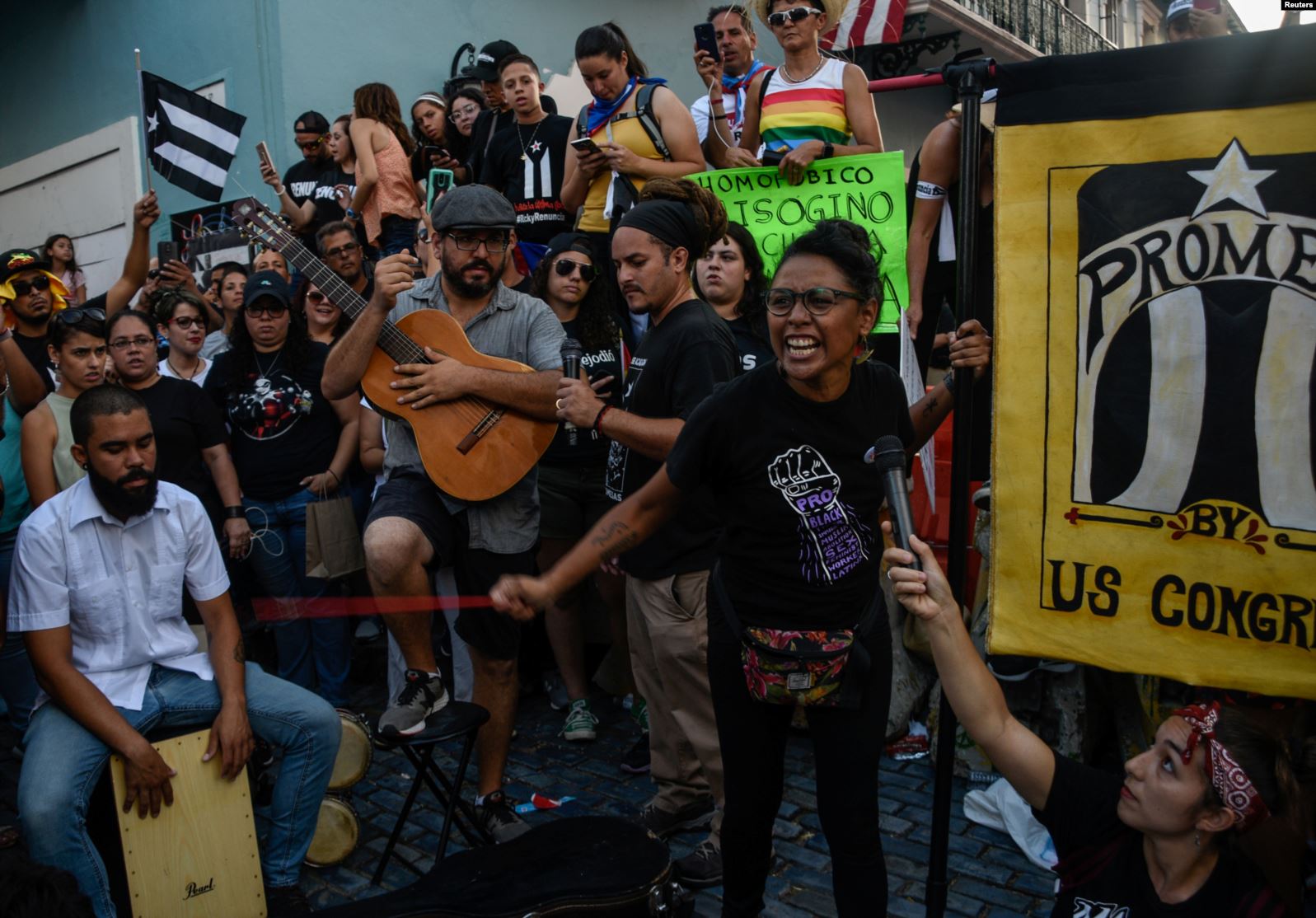
Foto por Gabriella N. Baez/REUTERS
AgitArte: Creative storytelling is an important part of AgitArte’s work. Can you share a story of your work with AgitArte that has been especially meaningful to you and/or have helped shape your development as an artist?
Sugeily:
This question immediately brings to mind the memory of my grandfather. He was a great storyteller. He told me every memory of his past in such a way that he seemed to be living it in the moment. As I listened to him attentively, I drew in my mind each image that he was building with his words. Their memories became mine too, and I began to live with them and those of my ancestors. The same thing happens at a collective level: we consume stories, we make them our own, we pass them on from generation to generation and many of them end up defining us. That is why, depending on who tells a story and how it is told, it can be a double-edged sword. Much of what we consider to be part of our collective memory has been misrepresented to perpetuate colonial narratives.
Part of my creative work with Papel Machete has been precisely to rescue the stories that have been invisibilized by the colonial governments as part of a repressive mechanism. In that sense, the rescuing of these memories is an act of resistance and collective transformation.
When I became part of Papel Machete, one of my proposals was to work on a piece about women with the female members. I remember that at that time Jorge had shared with me the book “Chronicle of a cover-up: Albizu Campos and the Rhoads case” by Pedro Aponte Vázquez. He had the idea of making a play based on that story, and over time that idea matured. We decided that the Rhoads story would not be the only one, that we would make several short pieces to expose different moments in our history when the United States government experimented with Puerto Ricans for the purpose of population control. I thought it was a good time to retake the proposal to create a piece with the bandmates from Papel Machete. We decided to rescue the history of the massive sterilization of women that occurred in Puerto Rico as part of a eugenics program imposed by the US government. What began in 2011 as a creative process culminated in the “Episodios del Genocidio Boricua y otros Relatos Deshumanizantes” (Episodes of the Boricua Genocide and other Dehumanizing Stories). This experience definitely redefined my role in Papel Machete, this being the first play that I co-directed with Jorge Díaz. In the process, I took on much of the development and facilitation of the collective workshops, and led much of the production.
I carry this process very close to my heart, especially the episode of “The Operation”, because we gave ourselves the space to speak and deepen our experiences as women in a continuous struggle against sexist and patriarchal violence. The basis for the creative process was based on the documentary “La Operación” by Ana María García, but it also drew on our personal stories and the stories of our mothers and grandmothers. So much so that the characters we represented were named after our mothers. With this piece we reaffirmed how we are made of these living fragments of memories and with them continue to fight against the imposition of colonial hegemony.
In 2014 Jorge gave me the news that AgitArte was going to rent the whole house, and we immediately began to shape all the ideas and projects that for years we had imagined we wanted to do if we had a “casa taller” (workshop house): a community space for popular education and cultural resistance.
AgitArte: You have been a major part of bringing Casa Taller Cangrejera in Puerto Rico to life and are directing a lot of the community and cultural programming happening there now. Can you share your experience developing Casa Taller and a few of the programs you’re excited about?
Sugeily:
I came to Papel Machete in 2009 when they had only a small room as a workshop and part of the balcony in the house on the corner of Martín Travieso and Rosario streets in Santurce. The work grew and with this the need for more space. In 2014 Jorge gave me the news that AgitArte was going to rent the whole house, and we immediately began to shape all the ideas and projects that for years we had imagined we wanted to do if we had a “casa taller” (workshop house): a community space for popular education and cultural resistance. This marked the beginning of a new phase for the creative work of Papel Machete but more importantly to establish more projects and works of cultural organization of AgitArte in Puerto Rico.
We decided to call the space Casa Taller Cangrejera (CTC). My first two years as the CTC coordinator were done by volunteer work and exchange for housing. That first year, we began by establishing an arts residency program and a community garden. I was one of the first artists to do a residency in the space with my daughter Valentina, which allowed me to connect even more with the community with which we were working and design programs that really served to reinforce existing projects and grow our base.
We have undertaken many projects ever since- all important to me – but if I had to highlight one, it would be our project of Mutual Support and Cultural Solidarity, which began just after the passage of Hurricanes Irma and María, and which continues today. Our CTC became an important meeting point for community organization. We have been able to employ strategies to give direct support to grassroots communities, artists and organizers, and to amplify our struggles through visual art, theater and media work.
I am also very excited about the agroecological training workshops in our Huerta garden with students and teachers from our community. This relationship began when one of the teachers close to our project saw the cantastoria by Papel Machete “Solidarity and Survival for Our Liberation”. We created this cantastoria right after the passage of Hurricane María to denounce the mismanagement of the disaster by the state and federal government, and to inform about existing community solidarity efforts during that moment. The teacher thought it necessary to share this message with students and peers at her school. The following year she got transferred to the Julián Blanco school, located closer to Casa Taller, which allowed us to grow our relationship with that school community. I communicated to our colleague in charge of the Huerta, Pluma Bárbara, the intention of carrying out a project with the students and teachers of the school through agroecology and food sovereignty workshops. Pluma then began to design the workshops, and by the following semester we had the students coming into our space.
We embarked this 2020 ready for a new semester with workshops inside of the school so new students could join in, we could meet more teachers and work closely with them, but due to the earthquakes early in the year and the current COVID-19 situation, we had to pause. Throughout these months, we have been able to face this new crisis, re-inventing ways to continue mutual support. I believe in the possibility of resuming our work with the community even in the face of adversity and the limitations of our current situation. Now more than ever, we are reaffirmed in our solidarity labor with the hope that these changes uproot all that doesn’t work and leaves us fertile soil to germinate a present that allows for healing and continuous growth.
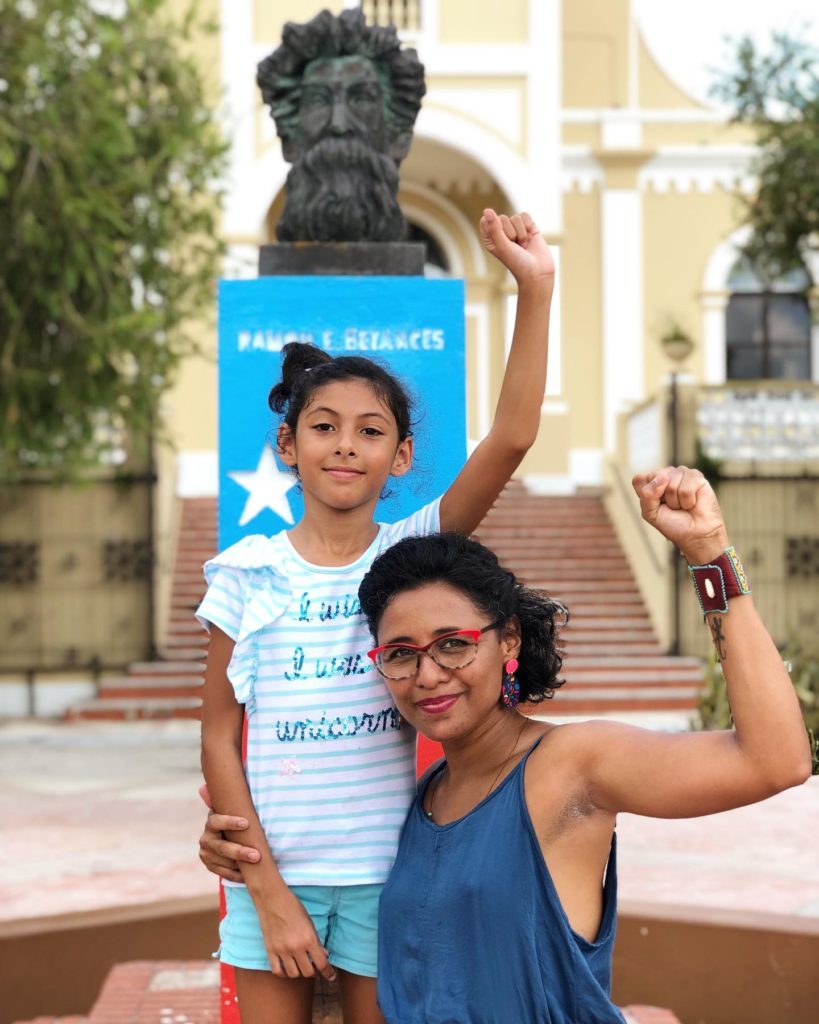
AgitArte: What’s next for you and your work with AgitArte? What upcoming projects are you most excited for and why?
Sugeily:
I am increasingly convinced that what I do with AgitArte is a job that is sustained by love and persistence. It is that love and the desire to see our liberation materialize in this life that keeps me moving forward. Right now we celebrate as a community that we have been able to acquire a new Casa Taller Cangrejera, a permanent home from which to continue growing. This is a space of liberation that we have fought and won, and from where we are going to achieve many other victories. I am excited to continue imagining and creating with my Papel Machete and AgitArte family. The next steps will always be to continue opening paths with them at the beginning of this new cycle, with a new house and as co-director of AgitArte together with Jorge Díaz, a companion in the struggle and in life. If there is something I have learned, it is that anything that we can imagine exists, therefore liberation will come anyway. That is why we continue, and what a joy to be able to do this alongside you all!
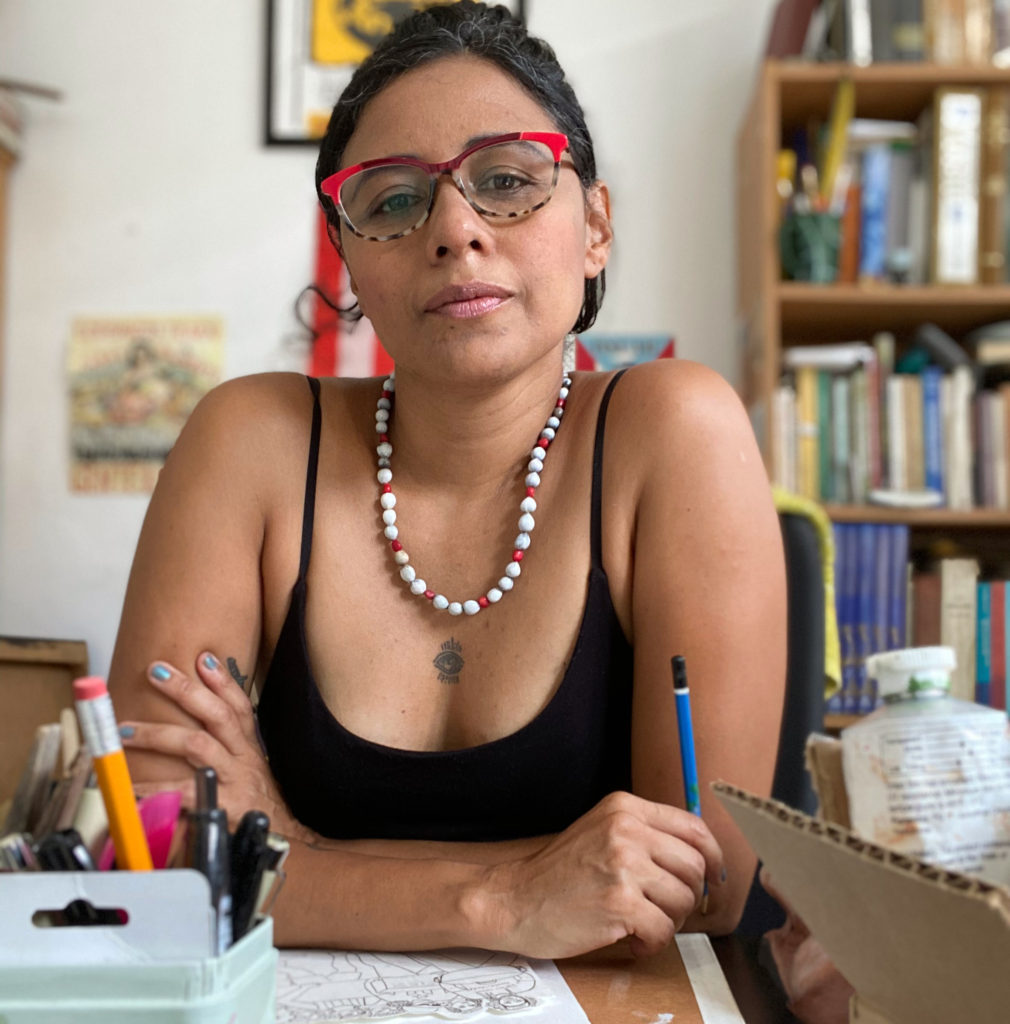
AgitArte: How did you first become engaged with AgitArte | Papel Machete?
Sugeily:
I met Jorge Díaz (Co-Director of AgitArte) in 2005 in Teatro Estudio Yerbabruja (Yerbabruja Studio Theatre) in Río Piedras. At that time, we were celebrating “Mixta con Tod@s 6” – a performance marathon – organized by Margarita Espada and Deborah Hunt. I helped run the event while Jorge participated in “ANIMAS”, a mask theater piece directed by Deborah Hunt in collaboration with people from “Santurce No Se Vende” (Santurce Is Not for Sale), a group composed by Santurce residents, artists, and workers who at that time were fighting against the expropriation of the San Mateo de Cangrejos neighborhood.
Following that first encounter, Jorge and I kept coincidentally meeting at protests, puppetry / mask making workshops, and theater events organized by Deborah. One of which was Titeretada, our annual puppetry festival in which we have been part of the organizing committee from its inception in 2008 to the present. This space allowed us to get to know each other’s work and deepen our friendship, but it wasn’t until summer of 2009 that I began collaborating directly with AgitArte and Papel Machete. Jorge called me to do two things: help facilitate a puppet workshop that AgitArte was organizing in Villa Cañona and participate in a parade with Papel Machete and the community during the traditional festivities of Santiago Apóstol in Loiza.
The purpose was to protest against the racist expressions of the then mayor of Loíza, who had threatened with suspending the festivities because he considered them “from the devil”, in a violent attempt to whiten and gentrify a predominantly black community and its culture. I remember arriving at the communal center of Villa Cañona with a bag full of brushes and paints to facilitate a puppet and mask workshop together with Jorge and colleagues from Papel Machete, and then march in protest with the community under the slogan “Cultura es Lucha” (Culture is Fight). It was there, among puppets, banners, music, vejigantes and community cultural resistance, that my journey with AgitArte and Papel Machete began.
I joined Papel Machete in 2009 and shortly afterwards was invited to be part of the Board of Directors of AgitArte, in which I participated for 6 years. My relationship with Papel Machete and AgitArte has been united from the beginning: they are my family, our house-entrenchment, and creative sanctuary; from there we continue to fight for our liberation and for a transformation of our society that ensures a dignified and fair life for all.

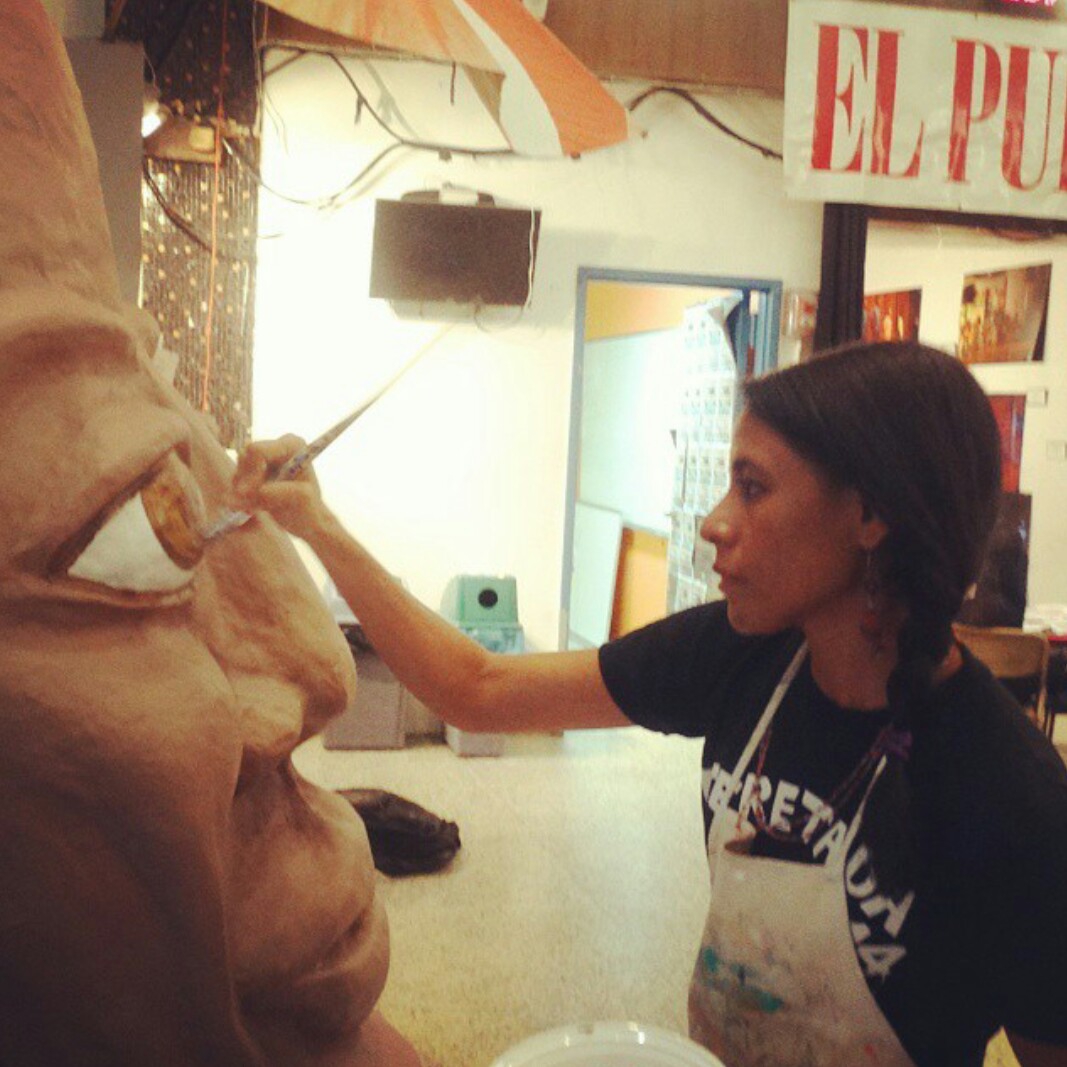
AgitArte: What is your creative background, both in education and through other means of developing your artistic practice(s)?
Sugeily:
The first time I did theater I was 12 years old. The play dealt with different social problems that we were facing in our communities. From this point on my interest in theater began to grow and I signed up for a drama class when I moved on to middle school. During those years my mom encouraged me to join the school band. I learned (more or less) to play the flute, and I joined the marching band. In the afternoons when classes ended, we did our practices in the sun at 3pm, and sometimes we went out to march through the town. I was fascinated by the formations.
Around the same time, I began taking painting classes with former political prisoner Pablo Marcano García a few years after his release. Pablo is the only painting teacher I have ever had and was fundamental in my artistic and political development. Although these experiences occurred at a very elementary stage of my life, they defined much of what I do today, and many of them I owe to brave women: my mother Ana Cecilia, my grandmother Nereida and my great-aunt Luz María who always insisted in my artistic and political development.
I began studying at University of Puerto Rico in Cayey in 1995, and immediately joined the student organization Café Teatro and also started to work in the department of Cultural Activities. At Café Teatro I started doing the scenographies for the events and ended up chairing the organization for several years. One of the experiences that marked that university period was the Encuentro de Teatro Popular Latinoamericano, ENTEPOLA (Latin American Popular Theater Festival), an event that originated in Chile by the popular theater group “La Carreta.” At this festival, I met artists who were themselves activists and organizers from different countries in Latin America. Although I finished a bachelor’s degree in history, I took all possible electives in theater. Also during those years I led – together with other students – the fight for the preservation of our theater “La Casita de Histriones” which was threatened to be destroyed in order to build a natural sciences building. I owe my academic training in theater to my great teachers Jorge Luis Torres and Rafael Fuentes. During my senior year of university I decided to organize, together with Oscar González and Ivette Cruz, “Aspaviento”, an experimental theater group of puppets and objects.
The creation of Aspaviento coincides with the opening of the Teatro Estudio Yerbabruja. I arrived on the opening day in 2000 thanks to my friend and teacher Pedro Santaliz. There I met Margarita Espada and Deborah Hunt. I immediately got involved in Yerbabruja’s life helping organize the “Mixtas con tod@s”, as part of the Board of Directors and, alongside Deborah, with the administration of the theater. With Deborah, a new cycle begins in my artistic training. I started taking her puppet and mask workshops in 2003 and since then have collaborated and conspired together on different projects. Besides, the possibility of being part of Papel Machete while being able to collaborate with other artists keeps me in the spirit of continuing to learn and create.
Papel Machete has been my political home, my place of militancy, growth, and love. I feel I have learned more from my comrades than what I have been able to offer, this being such a skillfully diverse group of workers. I can’t imagine any fight not alongside them.
AgitArte: What do you feel you’ve gained as an artist through your work with AgitArte | Papel Machete? What do you feel have been your greatest contributions to AgitArte | Papel Machete?
Sugeily:
For me, AgitArte and Papel Machete are community, family and sustenance.. Working from a continuous scenario of crisis and survival is in itself an act of resistance. It always remains a challenge to create because you have to constantly give yourself without much possibility of time to recharge. Still we continue because we know that each day will bring what is necessary to sustain us.
I have seen how within the collective work, great and small victories are accomplished. Casa Taller Cangrejera is one of those big accomplishments. With much effort we have achieved a safe and necessary space to continue our work and to directly support the people’s struggle and grassroots artwork.
Papel Machete has been my political home, my place of militancy, growth, and love. I feel I have learned more from my comrades than what I have been able to offer, this being such a skillfully diverse group of workers. I can’t imagine any fight not alongside them.
I have gained all that I have learned. I feel I have been able to contribute with the direction of Papel Machete as an actress, puppeteer, musician, and visual artist and organizer, developing and facilitating workshops and programs, but above all, helping to maintain the heart of this collective beating, which is all of us who are part of Papel Machete / AgitArte, with the same love, commitment, and care with which we build and perform with our puppets on the streets. I feel I am a little piece of that gear, and it’s just there, on that journey, that we are.

Foto por Gabriella N. Baez/REUTERS
AgitArte: Creative storytelling is an important part of AgitArte’s work. Can you share a story of your work with AgitArte that has been especially meaningful to you and/or have helped shape your development as an artist?
Sugeily:
This question immediately brings to mind the memory of my grandfather. He was a great storyteller. He told me every memory of his past in such a way that he seemed to be living it in the moment. As I listened to him attentively, I drew in my mind each image that he was building with his words. Their memories became mine too, and I began to live with them and those of my ancestors. The same thing happens at a collective level: we consume stories, we make them our own, we pass them on from generation to generation and many of them end up defining us. That is why, depending on who tells a story and how it is told, it can be a double-edged sword. Much of what we consider to be part of our collective memory has been misrepresented to perpetuate colonial narratives.
Part of my creative work with Papel Machete has been precisely to rescue the stories that have been invisibilized by the colonial governments as part of a repressive mechanism. In that sense, the rescuing of these memories is an act of resistance and collective transformation.
When I became part of Papel Machete, one of my proposals was to work on a piece about women with the female members. I remember that at that time Jorge had shared with me the book “Chronicle of a cover-up: Albizu Campos and the Rhoads case” by Pedro Aponte Vázquez. He had the idea of making a play based on that story, and over time that idea matured. We decided that the Rhoads story would not be the only one, that we would make several short pieces to expose different moments in our history when the United States government experimented with Puerto Ricans for the purpose of population control. I thought it was a good time to retake the proposal to create a piece with the bandmates from Papel Machete. We decided to rescue the history of the massive sterilization of women that occurred in Puerto Rico as part of a eugenics program imposed by the US government. What began in 2011 as a creative process culminated in the “Episodios del Genocidio Boricua y otros Relatos Deshumanizantes” (Episodes of the Boricua Genocide and other Dehumanizing Stories). This experience definitely redefined my role in Papel Machete, this being the first play that I co-directed with Jorge Díaz. In the process, I took on much of the development and facilitation of the collective workshops, and led much of the production.
I carry this process very close to my heart, especially the episode of “The Operation”, because we gave ourselves the space to speak and deepen our experiences as women in a continuous struggle against sexist and patriarchal violence. The basis for the creative process was based on the documentary “La Operación” by Ana María García, but it also drew on our personal stories and the stories of our mothers and grandmothers. So much so that the characters we represented were named after our mothers. With this piece we reaffirmed how we are made of these living fragments of memories and with them continue to fight against the imposition of colonial hegemony.
In 2014 Jorge gave me the news that AgitArte was going to rent the whole house, and we immediately began to shape all the ideas and projects that for years we had imagined we wanted to do if we had a “casa taller” (workshop house): a community space for popular education and cultural resistance.
AgitArte: You have been a major part of bringing Casa Taller Cangrejera in Puerto Rico to life and are directing a lot of the community and cultural programming happening there now. Can you share your experience developing Casa Taller and a few of the programs you’re excited about?
Sugeily:
I came to Papel Machete in 2009 when they had only a small room as a workshop and part of the balcony in the house on the corner of Martín Travieso and Rosario streets in Santurce. The work grew and with this the need for more space. In 2014 Jorge gave me the news that AgitArte was going to rent the whole house, and we immediately began to shape all the ideas and projects that for years we had imagined we wanted to do if we had a “casa taller” (workshop house): a community space for popular education and cultural resistance. This marked the beginning of a new phase for the creative work of Papel Machete but more importantly to establish more projects and works of cultural organization of AgitArte in Puerto Rico.
We decided to call the space Casa Taller Cangrejera (CTC). My first two years as the CTC coordinator were done by volunteer work and exchange for housing. That first year, we began by establishing an arts residency program and a community garden. I was one of the first artists to do a residency in the space with my daughter Valentina, which allowed me to connect even more with the community with which we were working and design programs that really served to reinforce existing projects and grow our base.
We have undertaken many projects ever since- all important to me – but if I had to highlight one, it would be our project of Mutual Support and Cultural Solidarity, which began just after the passage of Hurricanes Irma and María, and which continues today. Our CTC became an important meeting point for community organization. We have been able to employ strategies to give direct support to grassroots communities, artists and organizers, and to amplify our struggles through visual art, theater and media work.
I am also very excited about the agroecological training workshops in our Huerta garden with students and teachers from our community. This relationship began when one of the teachers close to our project saw the cantastoria by Papel Machete “Solidarity and Survival for Our Liberation”. We created this cantastoria right after the passage of Hurricane María to denounce the mismanagement of the disaster by the state and federal government, and to inform about existing community solidarity efforts during that moment. The teacher thought it necessary to share this message with students and peers at her school. The following year she got transferred to the Julián Blanco school, located closer to Casa Taller, which allowed us to grow our relationship with that school community. I communicated to our colleague in charge of the Huerta, Pluma Bárbara, the intention of carrying out a project with the students and teachers of the school through agroecology and food sovereignty workshops. Pluma then began to design the workshops, and by the following semester we had the students coming into our space.
We embarked this 2020 ready for a new semester with workshops inside of the school so new students could join in, we could meet more teachers and work closely with them, but due to the earthquakes early in the year and the current COVID-19 situation, we had to pause. Throughout these months, we have been able to face this new crisis, re-inventing ways to continue mutual support. I believe in the possibility of resuming our work with the community even in the face of adversity and the limitations of our current situation. Now more than ever, we are reaffirmed in our solidarity labor with the hope that these changes uproot all that doesn’t work and leaves us fertile soil to germinate a present that allows for healing and continuous growth.

AgitArte: What’s next for you and your work with AgitArte? What upcoming projects are you most excited for and why?
Sugeily:
I am increasingly convinced that what I do with AgitArte is a job that is sustained by love and persistence. It is that love and the desire to see our liberation materialize in this life that keeps me moving forward. Right now we celebrate as a community that we have been able to acquire a new Casa Taller Cangrejera, a permanent home from which to continue growing. This is a space of liberation that we have fought and won, and from where we are going to achieve many other victories. I am excited to continue imagining and creating with my Papel Machete and AgitArte family. The next steps will always be to continue opening paths with them at the beginning of this new cycle, with a new house and as co-director of AgitArte together with Jorge Díaz, a companion in the struggle and in life. If there is something I have learned, it is that anything that we can imagine exists, therefore liberation will come anyway. That is why we continue, and what a joy to be able to do this alongside you all!

“QUOTE”
– José Jorge Díaz, Co-Director
CREATIVE WORK:
MORE ON SUGEILY:
Sugeily’s Artist Instagram | @sugeilyrodriguez.lebron
When We Fight, We Win! Webcast | Cultural Organizing + Rapid Response in Puerto Rico
The Paris Review | Puerto Rico Sketchbook: There Are Dead in the Fields by Molly Crabapple
The Paris Review | Puerto Rican Sketchbook: The Radical Artist Collective


